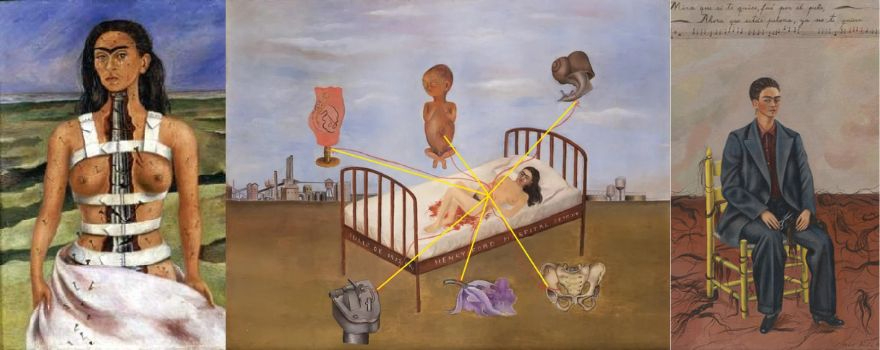The Art of Endurance: Frida Kahlo’s Fierce Legacy
30 JAN 2025
Frida Kahlo’s art was more than just self-expression; it was an unfiltered reflection of her pain, passion, and defiance against societal norms. Through vivid symbolism and deeply personal themes, she redefined the meaning of feminist resistance, leaving an everlasting impact on the world of art and culture.

L: The Two Fridas (Las dos Fridas) R: Self-Portrait with Thorn Necklace and Hummingbird
Frida Kahlo’s world was never meant to be contained within the confines of a frame. Her art, a swirling mix of pain and passion, was an open diary where every brushstroke whispered a secret, screamed a rebellion, or sang an ode to the parts of her existence that society often wished to overlook. She did not simply paint; she bled onto the canvas, offering the world an unfiltered look into the very fabric of her being.
From the moment she first touched a paintbrush, Frida Kahlo refused to be anything other than what she was. Her life was not shaped by convention but by the wounds she carried—some physical, some emotional, but all deeply personal. As a child, polio left her with a permanent limp. Later, a bus accident shattered her body, embedding shards of metal into her flesh and fracturing her spine, her legs, and her dreams of a typical future. She spent months confined to her bed, wrapped in plaster and pain, but even then, she found a way to express herself. With a specially designed easel and a mirror fixed above her, she turned inward, capturing her own gaze and, through it, the essence of her soul.
Self-portraits became her language, a form of communication that went beyond words. She painted herself not out of vanity but because she understood that her story—her suffering, her survival—was worth telling. Unlike many women artists before her, who were relegated to the periphery of the art world, she did not shy away from the deeply personal. She embraced it. Her canvases bore witness to her pain, her longing, and the complexities of love, desire, and despair.
She married Diego Rivera, a man whose name carried weight in the artistic circles of Mexico. He was larger than life—physically, artistically, and in his insatiable appetite for both creation and destruction. Their relationship was a tempest, marked by deep admiration and relentless betrayal. Diego was unfaithful, even with her own sister, and yet, despite the agony it brought her, Frida never allowed herself to be defined by his actions. She loved him fiercely but never lost herself in the process. If anything, her pain only sharpened her voice.


L: The Broken Column M: Henry Ford Hospital R: Self-Portrait with Cropped Hair
Her paintings reflected every wound, every heartbreak, every battle she fought—both within herself and against the world around her. In 'The Two Fridas,' she depicted two versions of herself sitting side by side, one heart exposed, bleeding onto her pristine white dress, the other holding the lifeline of her identity with quiet strength. In 'The Wounded Deer,' she cast herself as an animal struck by arrows, struggling forward despite the weight of suffering. Her works were not merely artistic expressions; they were confessions, declarations, and acts of defiance.
Despite the deeply personal nature of her art, Frida Kahlo’s influence extended far beyond her own life. She became a symbol of feminist expression, a voice for those who had been silenced, a challenge to the idea that only grand, overtly political themes could shape society. She proved that the most intimate moments—those spent alone, in pain, in love, in reflection—were just as powerful as revolutions. Her paintings rejected the notion that art had to fit within predetermined molds. She made it clear that personal stories, no matter how raw or delicate, had the power to shake the world.
Even the way she presented herself was an act of rebellion. She adorned herself in traditional Mexican Tehuana dresses, drawing attention not only to her heritage but also to the strength of indigenous women. She wove flowers into her hair, their vibrant hues mirroring the bold colors of her paintings. When she dressed in suits, cutting her hair short in an almost ceremonial rejection of societal norms, she sent a message without ever uttering a word. Her face, unaltered by the demands of beauty standards, bore her signature unibrow and mustache—a defiant refusal to conform.
Her physical pain never subsided. Multiple surgeries, endless medical treatments, and the relentless ache of her injuries followed her until the very end. But she did not allow it to silence her. Instead, she painted through the agony, using her suffering as fuel. Her final works were as poignant as ever, infused with a deep awareness of her mortality yet still brimming with the fiery spirit that had always defined her.
As the years passed, Frida Kahlo became more than an artist; she became a legend. Her name, once confined to Mexico’s art circles, spread across continents. Her image appeared on walls, in books, on tote bags, and even in fashion runways. And yet, beneath the commercialization, beneath the commodification of her face and flowers, her essence remained intact. The fire that burned in her paintings, the raw honesty of her work, could never be diluted.
Frida did not just create art; she created a movement. She proved that the personal was not only political but also revolutionary. In a world that often tried to suppress women’s voices, she roared through her canvases, leaving behind a legacy that would continue to inspire for generations. Her story, woven into the very fabric of her paintings, remains a testament to the power of authenticity, resilience, and the unbreakable spirit of an artist who refused to be confined by anything—not by pain, not by love, and certainly not by the expectations of society.
1733315688.jpg)
1733735496.jpg)
1732017533.jpg)


















